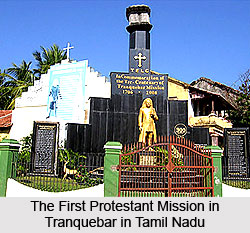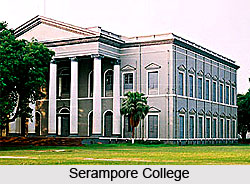 There are more than 5 million Protestants in India and most of them live in the northern and eastern regions. In 1706 Frederick IV of Denmark sent out two Germans, Bartholomew Ziegenbalg and Henry Pluetschau, who established the first Protestant mission in Tranquebar in Tamil Nadu.
There are more than 5 million Protestants in India and most of them live in the northern and eastern regions. In 1706 Frederick IV of Denmark sent out two Germans, Bartholomew Ziegenbalg and Henry Pluetschau, who established the first Protestant mission in Tranquebar in Tamil Nadu.
In India, the Protestant missionaries had also to contend with Catholics, who had been doing the work of proselytisation for many centuries and south of the Godavary had made Catholicism more or less an indigenous creed.
Within the Protestants there were several divisions. After the Reformation had spread all over Europe hundreds of sects developed from the Protestant matrix. Some of these that are active in India are the Presbyterian, Methodist, Baptist, Anglican, Mar Thoma Syrian Church, Assembly of God and the Seventh Day Adventist.
Martin Luther had declared that the Bible, and not the Pope, was the infallible authority, and that it should be taught to the people in their own language rather than Latin. Liberated from its linguistic shackles, the Protestants took it upon themselves to spread the word of God all over the world. The Society for the Propagation of the Gospel was founded in America in 1701. A few years later, the first Protestant Mission was established in India.
The former Anglicans and most of the Protestants are now united into two great Churches, the Church of South India formed in 1847 and the Church of North India formed in 1970.
Missionary Activity: Christian missionary activity actually came to northern India with the British but the early British were indifferent and at times even hostile to the missions. They being practical, business minded people and traders and having established their entrée pots in India were more interested in profit than proselytisation. Consequently they adopted a policy of remaining neutral in matters of religion. On the other hand, the Spanish and the Portuguese were Roman Catholics and were committed to winning heathen souls for the pope. Their forcible conversions of the natives and their Inquisition in Goa made the Indians hate and fear them.
 The missionaries, however, found a great supporter in Charles Grant, who served in Bengal as an official of East India Company. Later, despite the ban which the East India Company had placed on the entry of missionaries, William Carey arrived in India in 1799 to set up his Baptist Mission and printing press at Serampore, near Kolkata.
The missionaries, however, found a great supporter in Charles Grant, who served in Bengal as an official of East India Company. Later, despite the ban which the East India Company had placed on the entry of missionaries, William Carey arrived in India in 1799 to set up his Baptist Mission and printing press at Serampore, near Kolkata.
In England, more missionaries agitated against the ban which was removed in 1813 enabling many religious organisations to send missionaries out to India for evangelical and social work.
By the end of the 19th century many changes had occurred in outlook abroad. Churches had become more active and missionaries were extending the spiritual frontier to the East.
The Serampore Baptist Mission was largely responsible for propagating the gospel in the north-east of the country. By 1818 it was running 127 vernacular schools where ten thousand people received "simple instruction in Christian religion." The famous Serampore College was opened in 1821.
There were ninety thousand Protestants in India in 1851 and by 1871 the number had doubled. More than half had been converted by American missionaries. During the famine of 1891, the Methodists converted fifteen thousand people.
In the second decade of this century, many Protestant missionaries realised that Hindu religious ideas (such as that of bhakti) should be utilised to present the Gospel. The study of Hindu religion was thus made essential for missionaries.
The National Christian Council consists of 19 Indian Churches which include most of the Protestant Churches, the Mar Thoma Church, the Chaldean Syrian Church of the East, as well as the Bible Society of India, the YMCA, etc. The National Christian Council`s Christian Service Agency has provided massive aid and relief to the Bangladesh and Tibetan refugees.




















